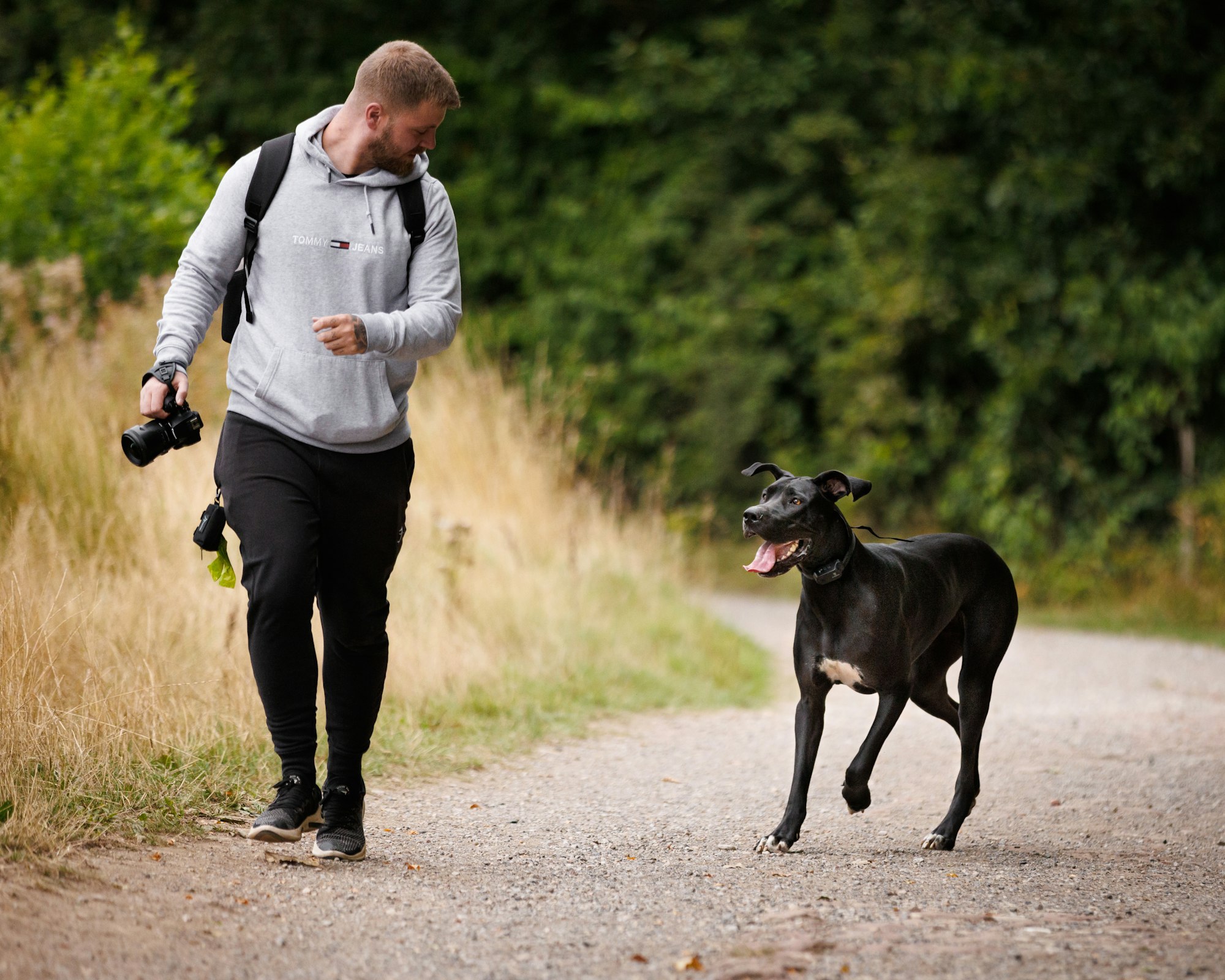Dogs, often referred to as man's best friend, have shared our lives for millennia. Their loyalty, companionship, and unwavering love have endeared them to us. However, beneath their domesticated exterior, dogs possess a set of natural instincts that hark back to their wild ancestors. In this article, we will delve into these instincts, shedding light on why they matter and how they influence your canine companion's behavior.

The Pack Mentality
Dogs, by their very nature, are descendants of pack animals, and this deeply ingrained pack mentality shapes their behavior and interactions. Understanding this fundamental aspect of canine psychology is pivotal for every dog owner.
Dogs as Social Animals
At the core of a dog's pack mentality is their social nature. Historically, their survival depended on the strength of their pack, emphasizing the importance of companionship and cooperation. In today's domestic setting, dogs still seek social bonds, making them reliant on their human pack.
Hierarchy and Leadership
Within every pack, there is a hierarchy. The alpha, or pack leader, holds a position of authority. Even though your dog may not be living in a wild pack, these hierarchical behaviors persist. Dogs often look to their human owners to assume the role of the alpha. Recognizing and embracing this leadership role helps maintain a harmonious relationship with your furry friend.

Hunting and Prey Drive
While your cuddly canine may seem far removed from its wild ancestors, the instinct to hunt and chase prey remains deeply rooted in their genetic makeup.
Unleashing the Hunter Within
Each dog possesses an inner hunter. The thrill of the chase, the pursuit of a target, and the satisfaction of a successful catch are part of their primal instincts. This instinctual drive can be harnessed positively through appropriate activities and training.
Tapping into Prey Drive for Fun and Exercise
To keep your dog mentally and physically stimulated, consider activities that cater to their prey drive. Games like fetch, tug-of-war, and interactive toys simulate hunting and provide a healthy outlet for their energy. These activities not only keep them physically fit but also mentally engaged, reducing boredom and potentially destructive behavior.
Territorial Behavior
Territorial behavior is a fundamental aspect of a dog's instincts, deeply rooted in their ancestry as hunters and protectors. Understanding and managing this instinct is essential for harmonious coexistence with your canine companion.
Defining Their Territory
Dogs are territorial animals. In the wild, defining and defending territory was crucial for survival. In our homes, this instinct often manifests as a need to mark and protect their space. Recognizing this behavior is the first step in addressing it.
Addressing Aggression and Protectiveness
Territorial behavior can escalate into aggression if left unchecked. It's crucial to differentiate between a dog's protective instincts and aggressive tendencies. Proper training and socialization play key roles in helping dogs understand when protection is necessary and when it's not.
Maternal Instincts
Maternal instincts in dogs are a testament to the remarkable bond between a mother and her offspring. Understanding and supporting these instincts are vital, especially during the early stages of a dog's life.
Nurturing Puppies
Female dogs display profound maternal instincts when caring for their pups. This instinct drives them to provide warmth, nourishment, and protection to their offspring. As a dog owner, your role is to support and facilitate this nurturing environment.
How to Support a Mother Dog
Ensuring the well-being of a mother dog and her puppies requires attention to detail. Proper nutrition, a safe and clean whelping area, and regular veterinary check-ups are essential components of supporting maternal instincts. Additionally, providing emotional support to the mother dog helps her feel secure and confident in her role as a caregiver.
Communication through Body Language
Communication through body language is the primary means by which dogs convey their thoughts, emotions, and intentions. Mastering the art of deciphering these signals is essential for any responsible dog owner.
The Subtle Art of Canine Communication
Dogs communicate with remarkable subtlety through body language. Their expressions, postures, and movements speak volumes about their feelings. By becoming attuned to these cues, you can better understand your dog's state of mind and respond appropriately.
Understanding Tail Wagging, Barking, and Postures
Tail wagging, barking, and various postures are among the most common ways dogs communicate. Each tail wag, bark, or stance conveys a specific message. Recognizing the difference between an excited wag and a nervous one, or between a playful bark and an alert one, empowers you to engage more effectively with your furry friend.

Problem Solving and Intelligence
Dogs are remarkably intelligent creatures, capable of solving problems and adapting to various situations. Nurturing their problem-solving abilities not only enhances their mental agility but also strengthens the bond between you and your canine companion.
The Clever Canine Mind
Dogs possess an innate ability to solve problems. This intelligence is a remnant of their history as hunters and problem solvers in the wild. Understanding the intricacies of their cognitive abilities allows you to tap into their potential.
Channeling Intelligence for Training
Intelligent dogs thrive on mental stimulation. Harnessing their problem-solving skills during training sessions not only makes learning more engaging for them but also fosters a deeper connection. Using positive reinforcement techniques, you can encourage your dog to solve puzzles, learn new tricks, and adapt to various situations, enriching their life and yours.
Digging and Burrowing Instincts
Digging and burrowing instincts are deeply ingrained in a dog's genetic makeup, harking back to their ancestors' survival strategies. Understanding these instincts and managing them appropriately is essential for a harmonious coexistence with your canine companion.
Why Dogs Dig
Digging is an instinctual behavior rooted in a canine's need to create shelter, hide dog food, or simply find comfort. This behavior can become problematic when it leads to destroyed gardens or holes in your yard. Recognizing the reasons behind your dog's digging is the first step toward addressing this instinct.
Creating a Digging Zone
A practical approach to managing digging instincts is to designate a specific area where your dog is allowed to dig freely. By providing an outlet for this natural behavior, you can protect your garden while ensuring your furry friend remains content.
Grooming Instincts
Grooming instincts are an integral part of a dog's daily routine, serving both functional and social purposes. Understanding these instincts and actively supporting them is vital for your dog's overall health and well-being.
The Importance of Self-Care
Dogs engage in grooming behaviors to keep themselves clean and healthy. This instinct is crucial for maintaining their fur, skin, and overall hygiene. Neglecting grooming needs can lead to discomfort and health issues.
Grooming Habits and Health
As a responsible dog owner, it's essential to facilitate your dog's grooming routines. This includes brushing, bathing, and regular inspections for any signs of skin conditions or parasites. Regular grooming not only enhances your dog's comfort but also strengthens your bond as you provide care and attention to their needs.
Guarding and Protective Instincts
Guarding and protective instincts are inherent in many dog breeds and play a crucial role in a dog's role as a companion and protector. Understanding these instincts and striking the right balance between protection and socialization is essential for responsible dog ownership.
Guard Dogs and Their Role
Certain breeds have a natural predisposition to guard and protect. These dogs are often used as guard dogs, protecting homes, livestock, and families. Recognizing and respecting this inherent protective nature is vital for harnessing it effectively.
Balancing Protection with Socialization
While guarding instincts are valuable, it's essential to ensure that your protective dog remains social and friendly with guests, family members, and other pets. Proper training and socialization play a significant role in achieving this balance. You can maintain a loving and secure home while also having a vigilant protector.

Swimming and Water Instincts
Swimming and water instincts vary among dog breeds, but many dogs have a natural affinity for water. Understanding and nurturing these instincts can lead to enjoyable water-related activities for both you and your furry friend.
Water-Loving Breeds
Some dog breeds are naturally drawn to water and excel in aquatic activities. Recognizing if your dog falls into this category can help you tailor water-related experiences to their preferences.
Teaching a Dog to Swim
Even if your dog isn't initially comfortable in the water, you can teach them to swim gradually and safely. Water can be an excellent source of exercise and enjoyment for your dog, provided you introduce it in a positive and supportive way.
Playful Instincts
Playful instincts are at the core of a dog's joyful disposition. Understanding and encouraging these instincts is essential for fostering a happy and healthy relationship with your canine companion.
The Joy of Playtime
Play is not just a pastime for dogs; it's a fundamental need. Playful instincts drive their desire for engagement, interaction, and exercise. Recognizing the significance of play in your dog's life is the first step in providing them with a fulfilling experience.
Toys and Activities for Engagement
Toys and activities designed to cater to your dog's playful nature are abundant. Whether it's a game of fetch, interactive dog toys, or simply rolling in the grass, engaging in play enhances your bond, stimulates your dog mentally, and keeps them physically active. Discovering the types of play your dog enjoys most is key to providing them with an enriched life.
Chasing Instincts
The thrill of the chase is a deeply ingrained instinct in dogs, one that harks back to their days as hunters and trackers. Recognizing and managing chasing instincts is vital for the safety and enjoyment of both your dog and those around them.

The Thrill of the Chase
Chasing is a high-energy instinct that can be triggered by various stimuli, such as moving objects, animals, or even other dogs. This instinct, when harnessed appropriately, can be a fun and interactive way to engage with your dog.
Safely Managing Chasing Behavior
While chasing can be entertaining for both you and your dog, it's crucial to manage it safely. Proper training and commands can help you control your dog's chasing tendencies, ensuring they remain safe and under your command during outdoor activities.
Instinctual Training and Enrichment
Leveraging your dog's natural instincts for training and enrichment is a smart way to tap into their cognitive abilities and create a stronger bond between you and your furry friend.
Using Natural Instincts in Training
Understanding your dog's natural behaviors, such as herding or retrieving instincts, can be harnessed for effective training. Incorporating these instincts into your training sessions not only makes learning more engaging for your dog but also helps them excel in activities that align with their innate talents.
Enrichment Ideas for a Happy Dog
Enrichment activities cater to your dog's instincts, providing mental stimulation and physical exercise. Activities like scent work, puzzle toys, and hide-and-seek games tap into your dog's problem-solving abilities and satisfy their desire for mental engagement.
Conclusion
In conclusion, understanding and embracing your dog's natural instincts can strengthen your bond and create a happier, healthier pet. By acknowledging these innate behaviors, you can provide the right environment and training to allow your dog to thrive.
Frequently Asked Questions (FAQs)
- Q: How can I tell if my dog is displaying territorial behavior?
- A: Watch for signs such as excessive barking at perceived threats, guarding specific areas, and defensive postures.
- Q: What's the best way to introduce my dog to water if they've never swum before?
- A: Gradual introduction in a shallow, calm area with positive reinforcement is key. Some dogs may benefit from a canine life vest.
- Q: Can I train my dog to stop digging in my garden?
- A: Yes, you can redirect their digging instincts to a designated area and use positive reinforcement to discourage garden digging.
- Q: Is it safe to engage in play that triggers my dog's chasing instincts?
- A: Yes, as long as you use safe toys and boundaries to ensure the activity doesn't become overly intense or unsafe.
- Q: How can I strike a balance between being my dog's leader and a loving companion?
- A: Consistent training, clear boundaries, and positive reinforcement can help you establish leadership while maintaining a loving relationship.
In this comprehensive article, we've explored the intricate world of a dog's instincts. Understanding these behaviors not only enriches your relationship with your canine companion but also helps you provide a fulfilling and healthy life for them. Embrace their instincts, nurture their well-being, and watch your furry friend flourish.




